Abstract
In the mammalian neostriatum, dopamine modulates neuronal responses mediated by activation of excitatory amino acid receptors. The direction of this modulation varies with the specific subtype of excitatory amino acid receptor activated. Responses evoked by iontophoretic application of glutamate (Glu) and the non-N-methyl-D-aspartate (NMDA) agonists quisqualate and alpha-amino-3-hydroxy-5-methyl-4- isoxazolepropionic acid were significantly attenuated when dopamine was applied. In contrast, responses evoked by NMDA were markedly potentiated. The enhancement of NMDA-evoked excitations was mimicked by bath application of SKF 38393, a D1 receptor agonist. The D1 receptor antagonist SCH 23390 blocked the dopamine enhancement of NMDA-induced excitations. Quinpirole, a D2 receptor agonist, attenuated responses evoked by both NMDA and non-NMDA receptor agonists. These results indicate that the complex modulatory actions of dopamine in the neostriatum are a function of the excitatory amino acid receptor as well as the specific dopamine receptor subtype activated. These findings are of clinical relevance since the actions of dopamine and excitatory amino acids have been implicated in neurological and affective disorders.
Full text
PDF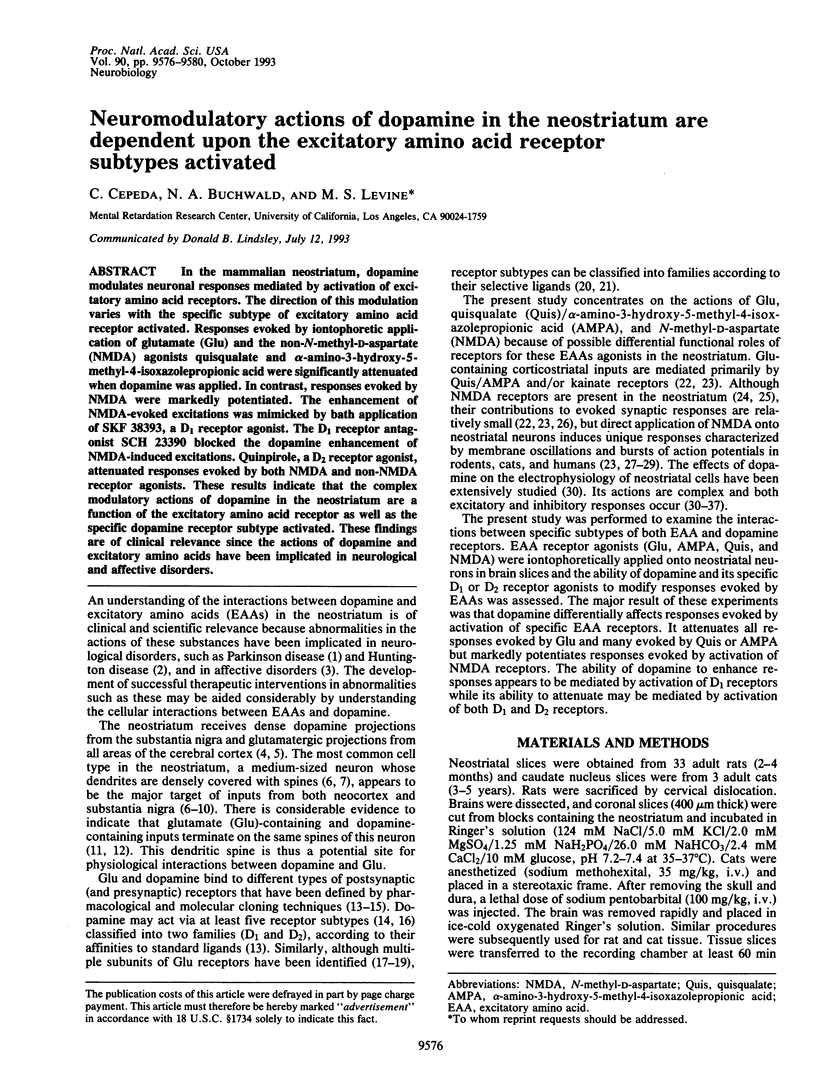
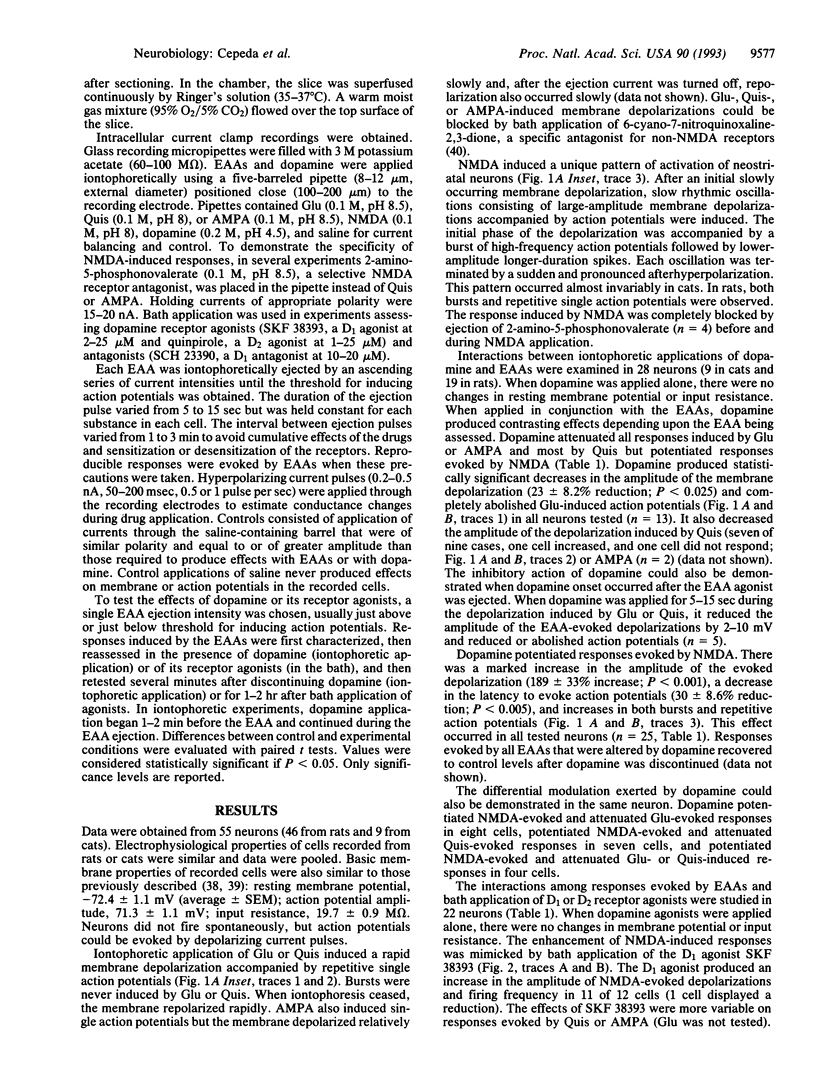
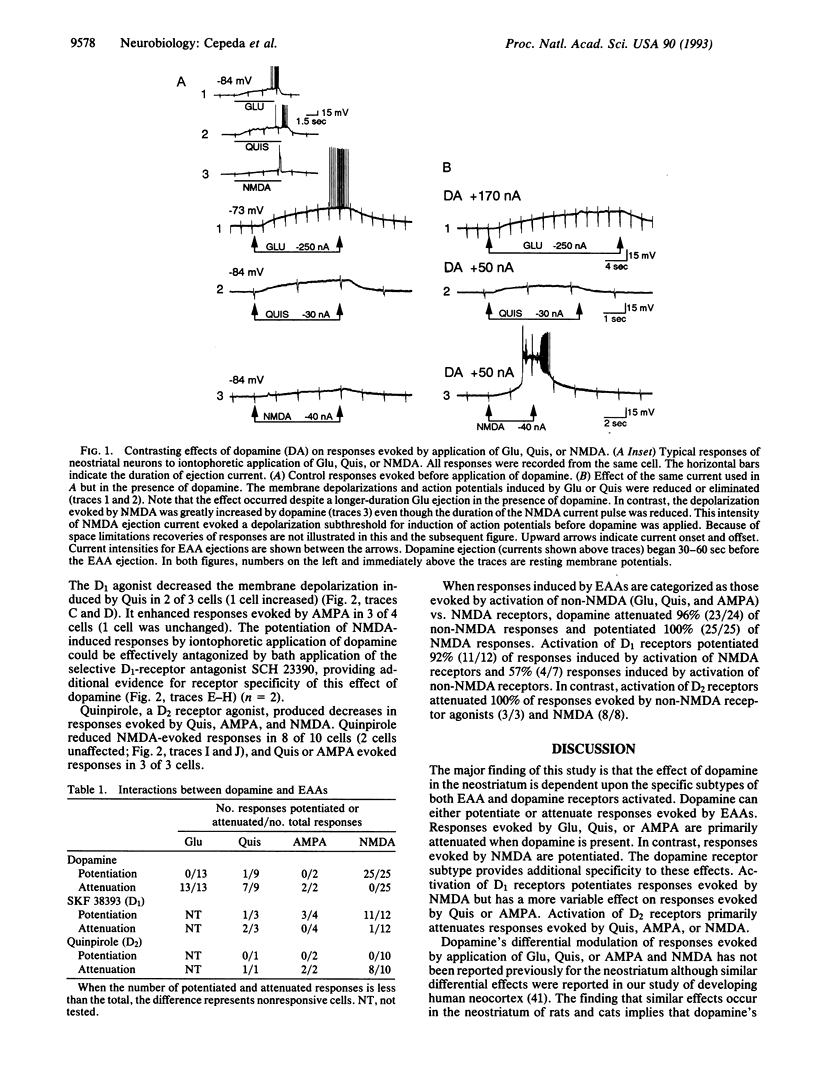
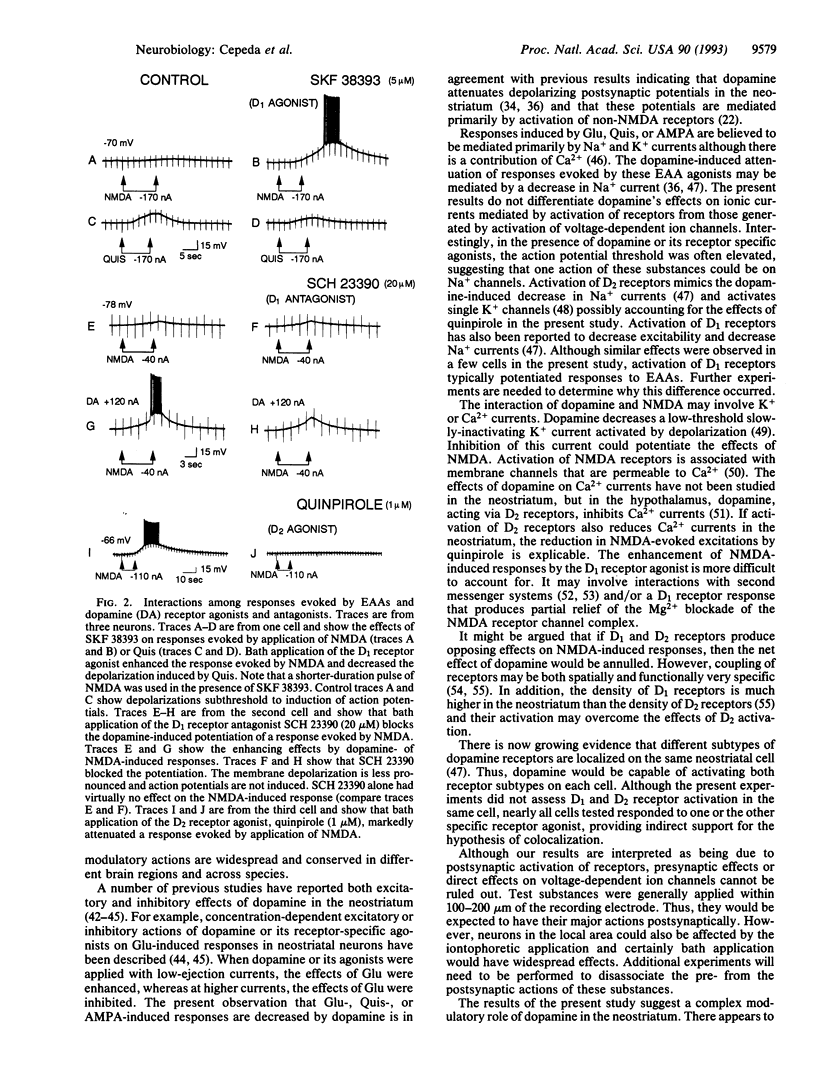
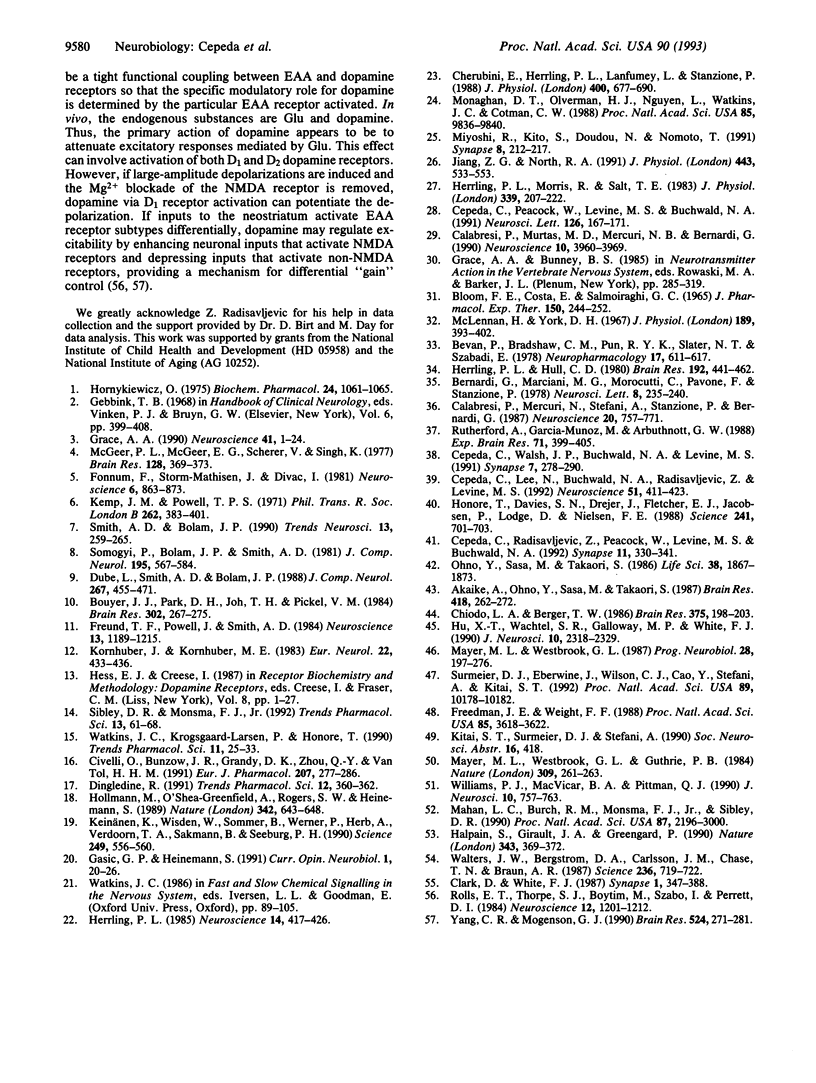
Selected References
These references are in PubMed. This may not be the complete list of references from this article.
- Akaike A., Ohno Y., Sasa M., Takaori S. Excitatory and inhibitory effects of dopamine on neuronal activity of the caudate nucleus neurons in vitro. Brain Res. 1987 Aug 25;418(2):262–272. doi: 10.1016/0006-8993(87)90094-1. [DOI] [PubMed] [Google Scholar]
- Bevan P., Bradshaw C. M., Pun R. Y., Slater N. T., Szabadi E. Responses of single cortical neurones to noradrenaline and dopamine. Neuropharmacology. 1978 Aug;17(8):611–617. doi: 10.1016/0028-3908(78)90156-9. [DOI] [PubMed] [Google Scholar]
- Bloom F. E., Costa E., Salmoiraghi G. C. Anesthesia and the responsiveness of individual neurons of the caudate nucleus of the cat to acetylcholine, norepinephrine and dopamine administered by microelectrophoresis. J Pharmacol Exp Ther. 1965 Nov;150(2):244–252. [PubMed] [Google Scholar]
- Bouyer J. J., Park D. H., Joh T. H., Pickel V. M. Chemical and structural analysis of the relation between cortical inputs and tyrosine hydroxylase-containing terminals in rat neostriatum. Brain Res. 1984 Jun 8;302(2):267–275. doi: 10.1016/0006-8993(84)90239-7. [DOI] [PubMed] [Google Scholar]
- Calabresi P., De Murtas M., Mercuri N. B., Bernardi G. Kainic acid on neostriatal neurons intracellularly recorded in vitro: electrophysiological evidence for differential neuronal sensitivity. J Neurosci. 1990 Dec;10(12):3960–3969. doi: 10.1523/JNEUROSCI.10-12-03960.1990. [DOI] [PMC free article] [PubMed] [Google Scholar]
- Calabresi P., Mercuri N., Stanzione P., Stefani A., Bernardi G. Intracellular studies on the dopamine-induced firing inhibition of neostriatal neurons in vitro: evidence for D1 receptor involvement. Neuroscience. 1987 Mar;20(3):757–771. doi: 10.1016/0306-4522(87)90239-9. [DOI] [PubMed] [Google Scholar]
- Cepeda C., Lee N., Buchwald N. A., Radisavljevic Z., Levine M. S. Age-induced changes in electrophysiological responses of neostriatal neurons recorded in vitro. Neuroscience. 1992 Nov;51(2):411–423. doi: 10.1016/0306-4522(92)90325-v. [DOI] [PubMed] [Google Scholar]
- Cepeda C., Peacock W., Levine M. S., Buchwald N. A. Iontophoretic application of NMDA produces different types of excitatory responses in developing human cortical and caudate neurons. Neurosci Lett. 1991 May 27;126(2):167–171. doi: 10.1016/0304-3940(91)90545-5. [DOI] [PubMed] [Google Scholar]
- Cepeda C., Radisavljevic Z., Peacock W., Levine M. S., Buchwald N. A. Differential modulation by dopamine of responses evoked by excitatory amino acids in human cortex. Synapse. 1992 Aug;11(4):330–341. doi: 10.1002/syn.890110408. [DOI] [PubMed] [Google Scholar]
- Cepeda C., Walsh J. P., Buchwald N. A., Levine M. S. Neurophysiological maturation of cat caudate neurons: evidence from in vitro studies. Synapse. 1991 Apr;7(4):278–290. doi: 10.1002/syn.890070405. [DOI] [PubMed] [Google Scholar]
- Cherubini E., Herrling P. L., Lanfumey L., Stanzione P. Excitatory amino acids in synaptic excitation of rat striatal neurones in vitro. J Physiol. 1988 Jun;400:677–690. doi: 10.1113/jphysiol.1988.sp017143. [DOI] [PMC free article] [PubMed] [Google Scholar]
- Chiodo L. A., Berger T. W. Interactions between dopamine and amino acid-induced excitation and inhibition in the striatum. Brain Res. 1986 Jun 4;375(1):198–203. doi: 10.1016/0006-8993(86)90976-5. [DOI] [PubMed] [Google Scholar]
- Civelli O., Bunzow J. R., Grandy D. K., Zhou Q. Y., Van Tol H. H. Molecular biology of the dopamine receptors. Eur J Pharmacol. 1991 Aug 14;207(4):277–286. doi: 10.1016/0922-4106(91)90001-x. [DOI] [PubMed] [Google Scholar]
- Clark D., White F. J. D1 dopamine receptor--the search for a function: a critical evaluation of the D1/D2 dopamine receptor classification and its functional implications. Synapse. 1987;1(4):347–388. doi: 10.1002/syn.890010408. [DOI] [PubMed] [Google Scholar]
- Dingledine R. New wave of non-NMDA excitatory amino acid receptors. Trends Pharmacol Sci. 1991 Oct;12(10):360–362. doi: 10.1016/0165-6147(91)90602-o. [DOI] [PubMed] [Google Scholar]
- Dubé L., Smith A. D., Bolam J. P. Identification of synaptic terminals of thalamic or cortical origin in contact with distinct medium-size spiny neurons in the rat neostriatum. J Comp Neurol. 1988 Jan 22;267(4):455–471. doi: 10.1002/cne.902670402. [DOI] [PubMed] [Google Scholar]
- Fonnum F., Storm-Mathisen J., Divac I. Biochemical evidence for glutamate as neurotransmitter in corticostriatal and corticothalamic fibres in rat brain. Neuroscience. 1981;6(5):863–873. doi: 10.1016/0306-4522(81)90168-8. [DOI] [PubMed] [Google Scholar]
- Freedman J. E., Weight F. F. Single K+ channels activated by D2 dopamine receptors in acutely dissociated neurons from rat corpus striatum. Proc Natl Acad Sci U S A. 1988 May;85(10):3618–3622. doi: 10.1073/pnas.85.10.3618. [DOI] [PMC free article] [PubMed] [Google Scholar]
- Freund T. F., Powell J. F., Smith A. D. Tyrosine hydroxylase-immunoreactive boutons in synaptic contact with identified striatonigral neurons, with particular reference to dendritic spines. Neuroscience. 1984 Dec;13(4):1189–1215. doi: 10.1016/0306-4522(84)90294-x. [DOI] [PubMed] [Google Scholar]
- Gasic G. P., Heinemann S. Receptors coupled to ionic channels: the glutamate receptor family. Curr Opin Neurobiol. 1991 Jun;1(1):20–26. doi: 10.1016/0959-4388(91)90006-s. [DOI] [PubMed] [Google Scholar]
- Grace A. A. Phasic versus tonic dopamine release and the modulation of dopamine system responsivity: a hypothesis for the etiology of schizophrenia. Neuroscience. 1991;41(1):1–24. doi: 10.1016/0306-4522(91)90196-u. [DOI] [PubMed] [Google Scholar]
- Halpain S., Girault J. A., Greengard P. Activation of NMDA receptors induces dephosphorylation of DARPP-32 in rat striatal slices. Nature. 1990 Jan 25;343(6256):369–372. doi: 10.1038/343369a0. [DOI] [PubMed] [Google Scholar]
- Herrling P. L., Hull C. D. Iontophoretically applied dopamine depolarizes and hyperpolarizes the membrane of cat caudate neurons. Brain Res. 1980 Jun 23;192(2):441–462. doi: 10.1016/0006-8993(80)90896-3. [DOI] [PubMed] [Google Scholar]
- Herrling P. L., Morris R., Salt T. E. Effects of excitatory amino acids and their antagonists on membrane and action potentials of cat caudate neurones. J Physiol. 1983 Jun;339:207–222. doi: 10.1113/jphysiol.1983.sp014712. [DOI] [PMC free article] [PubMed] [Google Scholar]
- Herrling P. L. Pharmacology of the corticocaudate excitatory postsynaptic potential in the cat: evidence for its mediation by quisqualate- or kainate-receptors. Neuroscience. 1985 Feb;14(2):417–426. doi: 10.1016/0306-4522(85)90301-x. [DOI] [PubMed] [Google Scholar]
- Hollmann M., O'Shea-Greenfield A., Rogers S. W., Heinemann S. Cloning by functional expression of a member of the glutamate receptor family. Nature. 1989 Dec 7;342(6250):643–648. doi: 10.1038/342643a0. [DOI] [PubMed] [Google Scholar]
- Honoré T., Davies S. N., Drejer J., Fletcher E. J., Jacobsen P., Lodge D., Nielsen F. E. Quinoxalinediones: potent competitive non-NMDA glutamate receptor antagonists. Science. 1988 Aug 5;241(4866):701–703. doi: 10.1126/science.2899909. [DOI] [PubMed] [Google Scholar]
- Hornykiewicz O. Parkinson's disease and its chemotherapy. Biochem Pharmacol. 1975 May 15;24(10):1061–1065. doi: 10.1016/0006-2952(75)90190-2. [DOI] [PubMed] [Google Scholar]
- Hu X. T., Wachtel S. R., Galloway M. P., White F. J. Lesions of the nigrostriatal dopamine projection increase the inhibitory effects of D1 and D2 dopamine agonists on caudate-putamen neurons and relieve D2 receptors from the necessity of D1 receptor stimulation. J Neurosci. 1990 Jul;10(7):2318–2329. doi: 10.1523/JNEUROSCI.10-07-02318.1990. [DOI] [PMC free article] [PubMed] [Google Scholar]
- Jiang Z. G., North R. A. Membrane properties and synaptic responses of rat striatal neurones in vitro. J Physiol. 1991 Nov;443:533–553. doi: 10.1113/jphysiol.1991.sp018850. [DOI] [PMC free article] [PubMed] [Google Scholar]
- Keinänen K., Wisden W., Sommer B., Werner P., Herb A., Verdoorn T. A., Sakmann B., Seeburg P. H. A family of AMPA-selective glutamate receptors. Science. 1990 Aug 3;249(4968):556–560. doi: 10.1126/science.2166337. [DOI] [PubMed] [Google Scholar]
- Kemp J. M., Powell T. P. The structure of the caudate nucleus of the cat: light and electron microscopy. Philos Trans R Soc Lond B Biol Sci. 1971 Sep 30;262(845):383–401. doi: 10.1098/rstb.1971.0102. [DOI] [PubMed] [Google Scholar]
- Kornhuber J., Kornhuber M. E. Axo-axonic synapses in the rat striatum. Eur Neurol. 1983;22(6):433–436. doi: 10.1159/000115598. [DOI] [PubMed] [Google Scholar]
- Mahan L. C., Burch R. M., Monsma F. J., Jr, Sibley D. R. Expression of striatal D1 dopamine receptors coupled to inositol phosphate production and Ca2+ mobilization in Xenopus oocytes. Proc Natl Acad Sci U S A. 1990 Mar;87(6):2196–2200. doi: 10.1073/pnas.87.6.2196. [DOI] [PMC free article] [PubMed] [Google Scholar]
- Mayer M. L., Westbrook G. L., Guthrie P. B. Voltage-dependent block by Mg2+ of NMDA responses in spinal cord neurones. Nature. 1984 May 17;309(5965):261–263. doi: 10.1038/309261a0. [DOI] [PubMed] [Google Scholar]
- Mayer M. L., Westbrook G. L. The physiology of excitatory amino acids in the vertebrate central nervous system. Prog Neurobiol. 1987;28(3):197–276. doi: 10.1016/0301-0082(87)90011-6. [DOI] [PubMed] [Google Scholar]
- McGeer P. L., McGeer E. G., Scherer U., Singh K. A glutamatergic corticostriatal path? Brain Res. 1977 Jun 10;128(2):369–373. doi: 10.1016/0006-8993(77)91003-4. [DOI] [PubMed] [Google Scholar]
- McLennan H., York D. H. The action of dopamine on neurones of the caudate nucleus. J Physiol. 1967 Apr;189(3):393–402. doi: 10.1113/jphysiol.1967.sp008175. [DOI] [PMC free article] [PubMed] [Google Scholar]
- Miyoshi R., Kito S., Doudou N., Nomoto T. Influence of age on N-methyl-D-aspartate antagonist binding sites in the rat brain studied by in vitro autoradiography. Synapse. 1991 Jul;8(3):212–217. doi: 10.1002/syn.890080307. [DOI] [PubMed] [Google Scholar]
- Monaghan D. T., Olverman H. J., Nguyen L., Watkins J. C., Cotman C. W. Two classes of N-methyl-D-aspartate recognition sites: differential distribution and differential regulation by glycine. Proc Natl Acad Sci U S A. 1988 Dec;85(24):9836–9840. doi: 10.1073/pnas.85.24.9836. [DOI] [PMC free article] [PubMed] [Google Scholar]
- Ohno Y., Sasa M., Takaori S. Excitation by dopamine D-2 receptor agonists, bromocriptine and LY 171555, in caudate nucleus neurons activated by nigral stimulation. Life Sci. 1986 May 19;38(20):1867–1873. doi: 10.1016/0024-3205(86)90142-6. [DOI] [PubMed] [Google Scholar]
- Rolls E. T., Thorpe S. J., Boytim M., Szabo I., Perrett D. I. Responses of striatal neurons in the behaving monkey. 3. Effects of iontophoretically applied dopamine on normal responsiveness. Neuroscience. 1984 Aug;12(4):1201–1212. doi: 10.1016/0306-4522(84)90014-9. [DOI] [PubMed] [Google Scholar]
- Rutherford A., Garcia-Munoz M., Arbuthnott G. W. An afterhyperpolarization recorded in striatal cells 'in vitro': effect of dopamine administration. Exp Brain Res. 1988;71(2):399–405. doi: 10.1007/BF00247499. [DOI] [PubMed] [Google Scholar]
- Sibley D. R., Monsma F. J., Jr Molecular biology of dopamine receptors. Trends Pharmacol Sci. 1992 Feb;13(2):61–69. doi: 10.1016/0165-6147(92)90025-2. [DOI] [PubMed] [Google Scholar]
- Smith A. D., Bolam J. P. The neural network of the basal ganglia as revealed by the study of synaptic connections of identified neurones. Trends Neurosci. 1990 Jul;13(7):259–265. doi: 10.1016/0166-2236(90)90106-k. [DOI] [PubMed] [Google Scholar]
- Somogyi P., Bolam J. P., Smith A. D. Monosynaptic cortical input and local axon collaterals of identified striatonigral neurons. A light and electron microscopic study using the Golgi-peroxidase transport-degeneration procedure. J Comp Neurol. 1981 Feb 1;195(4):567–584. doi: 10.1002/cne.901950403. [DOI] [PubMed] [Google Scholar]
- Surmeier D. J., Eberwine J., Wilson C. J., Cao Y., Stefani A., Kitai S. T. Dopamine receptor subtypes colocalize in rat striatonigral neurons. Proc Natl Acad Sci U S A. 1992 Nov 1;89(21):10178–10182. doi: 10.1073/pnas.89.21.10178. [DOI] [PMC free article] [PubMed] [Google Scholar]
- Walters J. R., Bergstrom D. A., Carlson J. H., Chase T. N., Braun A. R. D1 dopamine receptor activation required for postsynaptic expression of D2 agonist effects. Science. 1987 May 8;236(4802):719–722. doi: 10.1126/science.2953072. [DOI] [PubMed] [Google Scholar]
- Watkins J. C., Krogsgaard-Larsen P., Honoré T. Structure-activity relationships in the development of excitatory amino acid receptor agonists and competitive antagonists. Trends Pharmacol Sci. 1990 Jan;11(1):25–33. doi: 10.1016/0165-6147(90)90038-a. [DOI] [PubMed] [Google Scholar]
- Williams P. J., MacVicar B. A., Pittman Q. J. Synaptic modulation by dopamine of calcium currents in rat pars intermedia. J Neurosci. 1990 Mar;10(3):757–763. doi: 10.1523/JNEUROSCI.10-03-00757.1990. [DOI] [PMC free article] [PubMed] [Google Scholar]
- Yang C. R., Mogenson G. J. Dopaminergic modulation of cholinergic responses in rat medial prefrontal cortex: an electrophysiological study. Brain Res. 1990 Aug 6;524(2):271–281. doi: 10.1016/0006-8993(90)90701-c. [DOI] [PubMed] [Google Scholar]


